Bulletin – December 2011 Recent Changes in IMF Lending
- Download the article 1.2MB
Abstract
IMF lending has risen sharply in the wake of the global financial crisis from the lows in the mid 2000s. Despite increasing recently, the number of new IMF financing arrangements has been relatively small, but the average size of these arrangements is high by historical standards. Much of the new lending has been to Europe, which has resulted in marked changes in the geographical distribution of outstanding IMF loans. The terms on which lending has been made available have also changed in recent years, with the IMF implementing reforms aimed at making it easier for countries to access large loans, increasing its emphasis on the provision of precautionary financing, and streamlining its use of conditionality.
IMF Lending Activity[1]
One of the main roles of the IMF is to provide temporary financing to member countries with a balance of payments need. Financing is typically provided under an ‘arrangement’, which stipulates specific policies and measures (known as conditionality) that are intended to resolve a borrowing country's balance of payments difficulties. Disbursements of IMF loans to a country are generally dependent on the progress made by that country in implementing the agreed measures.
While a variety of arrangements are available to low-income countries on concessional terms, this article focuses on the IMF's non-concessional lending, which is subject to the IMF's market-related interest rate. Stand-By Arrangements (SBAs) and Extended Fund Facility (EFF) arrangements have historically accounted for the bulk of the IMF's non-concessional lending. SBAs are designed to help member countries address short-term balance of payments problems, while EFFs are available for countries with longer-term needs. A number of new facilities have also been introduced in recent years. One is the Flexible Credit Line (FCL), which is available to members with strong economic fundamentals and a track record of good economic policy. Another is the Precautionary Credit Line (PCL), which was previously available to countries possessing sound fundamentals, but also some vulnerabilities that precluded them from obtaining an FCL. In November 2011, the PCL was replaced by the Precautionary and Liquidity Line (PLL), which has the same qualification criteria as the PCL, but is available to countries with actual as well as potential balance of payments needs. This feature allows the PLL to be drawn down immediately upon approval, unlike the PCL, which was only available on a precautionary basis. When an arrangement is approved on a precautionary basis, a country opts not to draw on the approved amounts immediately, but retains the option to do so if conditions worsen. SBAs and FCLs can also be provided on either a precautionary or a non-precautionary basis.[2]
Both the number of new non-concessional lending arrangements and the total amount of lending committed under these arrangements have increased sharply in recent years (Graphs 1 and 2). Since the collapse of Lehman Brothers in September 2008, the IMF has approved 45 new arrangements, compared with 18 in the preceding four years.[3] Notably, however, the annual number of new arrangements approved during the recent crisis is still well below the number approved during earlier episodes of financial distress, including the 1980s debt crisis.
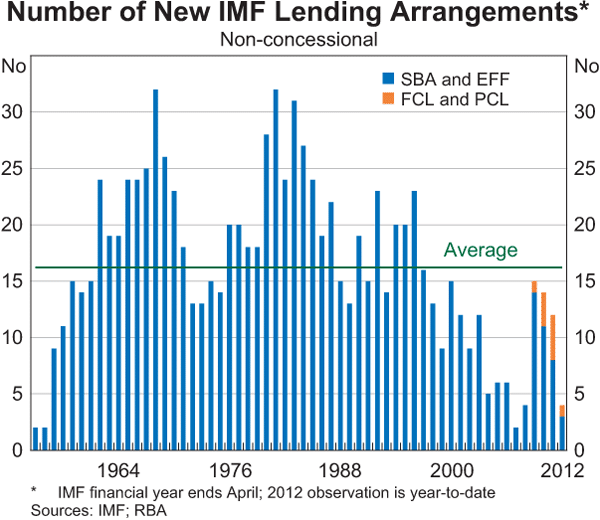
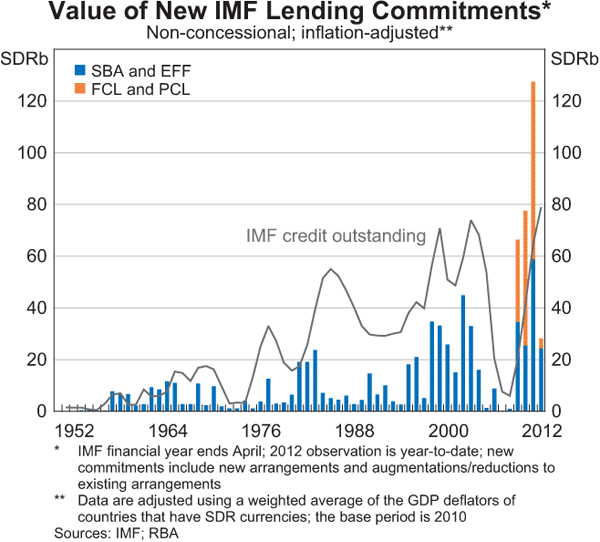
In the past four years, the IMF has approved around SDR300 billion of new non-concessional lending commitments.[4] While about half of this was under FCL arrangements, each of which were treated as precautionary and none of which were drawn, the average size of recent arrangements excluding the FCL has still been large by historical standards, both in absolute terms and measured relative to the recipient's quota subscriptions (see below).For instance, the average size of SBAs and EFFs approved during the IMF's 2011 financial year (to April) was SDR7.4 billion, compared with SDR2.3 billion during the 1997–98 Asian financial crisis (Graph 3).
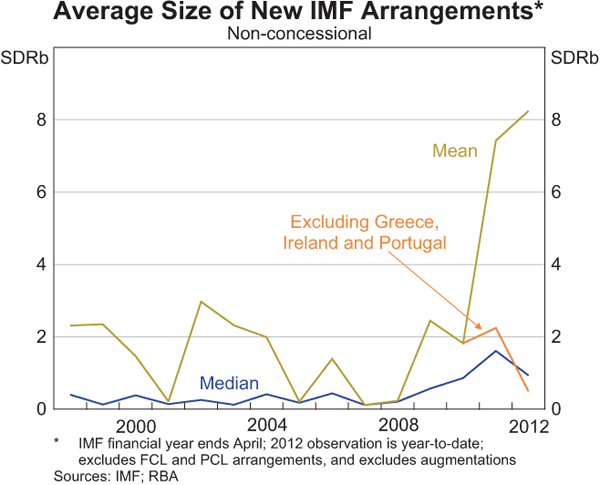
Much of the recent increase in lending has been to countries in Europe and the Commonwealth of Independent States (CIS).[5] These countries have accounted for around half of the arrangements that have been approved since September 2008, and have received about 90 per cent of the amount of new lending commitments (excluding commitments under FCL and PCL arrangements). As a result, outstanding IMF lending is now highly concentrated in Europe and the CIS region, which together account for 87 per cent of total credit outstanding (Graph 4).
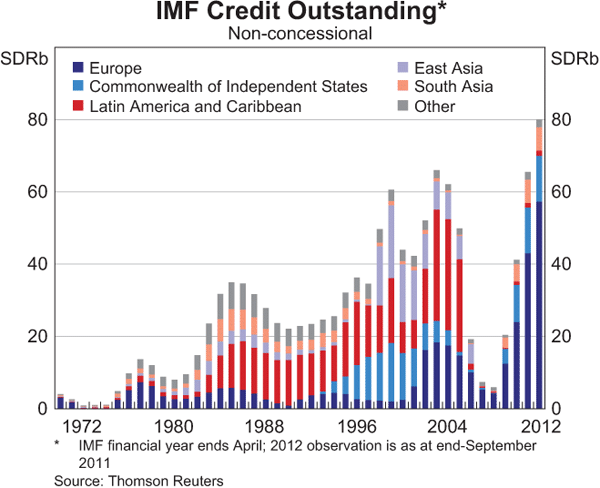
This is a marked change from earlier decades, during which IMF lending was more evenly distributed across regions, and Europe accounted for a relatively low share. This geographical shift partly reflects the external and financial sector vulnerabilities that had built up in many Eastern Europe and CIS economies prior to the crisis, and their close financial and economic links to the advanced countries at the centre of the crisis. In the year following the collapse of Lehman Brothers, the Ukraine, Hungary and Romania each received arrangements of more than SDR10 billion, while eight other European and CIS countries received loans totalling around SDR10 billion in the same year.
More recently, the sovereign debt problems in the euro area have seen Greece, Ireland and Portugal receive very large assistance packages from the IMF. These lending packages were organised in conjunction with the European Union, with the IMF providing around one-third of the €78 billion assistance to Portugal, and around one-quarter of the €85 billion pledged to Ireland and the €110 billion pledged to Greece.[6] Conversely, many of the economies in Asia and Latin America that borrowed from the IMF in the past entered the recent period of turmoil with relatively strong external positions. It has also been argued that the imposition of IMF conditionality in previous episodes of financial distress was regarded by the recipients as overly onerous, which may have led some emerging economies to seek alternatives during the recent crisis.[7]
Recent Changes to IMF Lending Practices
The IMF has recently implemented a number of changes to its lending practices in an effort to strengthen its capacity to both prevent and resolve crises. These changes include: a greater willingness to allow ‘exceptional access’ above ‘normal’ lending limits; an increase in the proportion of financing that is frontloaded; a shift in emphasis towards the provision of precautionary financing; and a more streamlined and focused use of conditionality.
Exceptional access and frontloaded financing
A useful way to measure the size of individual Fund arrangements is to scale them as a proportion of the recipient's ‘quota’ in the IMF, which is determined broadly on the basis of economic size and characteristics (the quota formula incorporates data on GDP, balance of payments flows, and official reserve holdings). A country's quota determines its maximum financial commitment to the IMF, and helps to determine the maximum size of any loan it can access – with the ‘normal’ lending limits of most Fund arrangements set at a fixed percentage of quota.
On this basis, the average access approved by the IMF in its non-concessional lending arrangements has increased markedly since 2008, to ratios well above historical norms (Graph 5). This indicates that recent IMF loans have been larger than in previous years, even after controlling for the size of the recipient. The increase can partly be attributed to the March 2009 reforms to IMF lending, in which the normal access limits of the SBA were doubled from 300 to 600 per cent of quota.[8] Since the reforms were passed, over half of the approved arrangements have been for amounts equivalent to more than 300 per cent of quota (Graph 6). The conditions that allow a country to obtain loans above normal lending limits (known as exceptional access criteria) were also eased as part of these reforms, and a number of countries affected by the recent crisis received exceptional access above the new 600 per cent threshold, including Greece (about 3,200 per cent of quota at the time of approval), Ireland and Portugal (both around 2,300 per cent of quota at the time of approval).
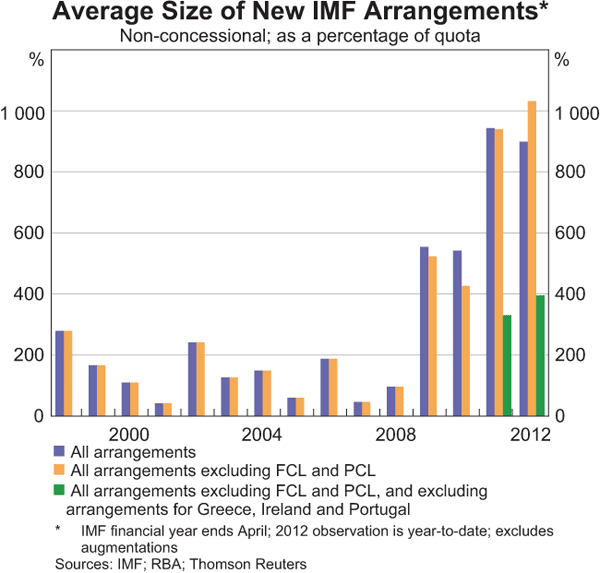
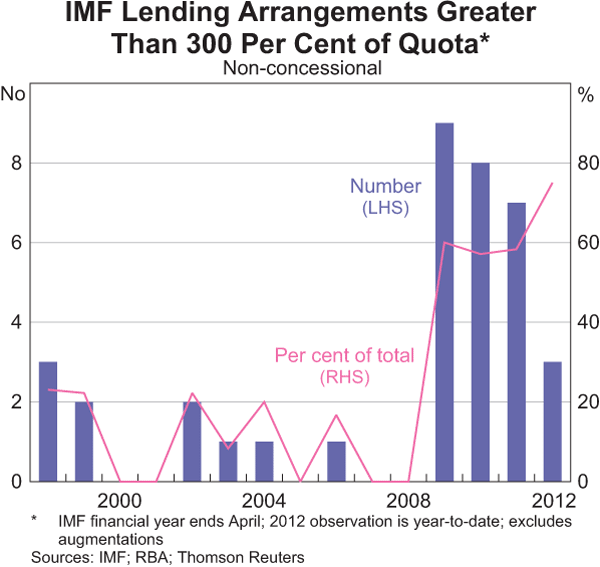
Most IMF lending is disbursed in a series of instalments, or ‘tranches’. The 2009 IMF lending reforms allowed SBA disbursements to be ‘frontloaded as appropriate’, on the basis that disbursing a larger proportion of financing in the initial stages of a Fund arrangement may, in some circumstances, help to boost confidence and insulate recipients from the effects of external shocks. IMF analysis suggests that the degree of frontloading in recent arrangements has been higher than in previous crises: the median value of the first tranche of lending equated to 35 per cent of total access for the 17 SBAs approved between mid 2008 and mid 2009, compared with a median of 26.5 per cent for arrangements approved in previous crises.[9] However, the degree of frontloading has been somewhat less in the more recent programs for Greece, Ireland and Portugal (averaging 22.5 per cent of total access).
Precautionary instruments and crisis prevention
Since 2009, the IMF has introduced new facilities and reformed existing arrangements with a focus on crisis prevention, rather than resolution. The FCL and the PLL, for instance, incorporate qualification criteria that are intended to signal strong economic fundamentals and policies, as well as a credit line designed to act as a buffer against future external shocks. Moreover, once a FCL is approved, disbursements are not subject to IMF conditionality (unlike the SBA and EFF; see below), and hence eligibility for FCL financing is based solely on meeting the qualification criteria.[10] These features are partly intended to mitigate the stigma that has been associated with IMF facilities in the past. As part of the package of reforms agreed in March 2009, the SBA was also upgraded to facilitate high-access borrowing on a precautionary basis for members that may not qualify for these newer facilities.
Despite these reforms, the proportion of arrangements approved on a precautionary basis has fallen slightly in recent times, from around 42 per cent of all non-concessional arrangements approved in the period from 1998 to 2008 to around 36 per cent of those approved since 2009. Moreover, only three countries (Mexico, Poland and Colombia) have signed up for the FCL since its introduction in 2009, and only one country had signed up for the PCL (FYR Macedonia) before it was replaced by the PLL this year. A possible reason for the limited take-up of these facilities is that residual stigma issues remain: some potential applicants may have feared that a FCL or a PCL could be interpreted as a signal of external vulnerability (despite the qualification criteria), or as an indication of dependence on the IMF. Other possible reasons include increased self-insurance through reserve accumulation, and the availability of alternative sources of financing such as swap lines.
The three countries that have signed up for the FCL have all renewed the facility twice, while not having drawn on the credit line component, suggesting that they see some benefit in the insurance and/or the market signal that the FCL provides. A feature of FCLs is that they tend to be approved for large amounts: Mexico and Poland renewed their FCLs for SDR47.3 billion (1,500 per cent of quota) and SDR19.2 billion (1,400 per cent of quota) in 2011, while Colombia renewed its FCL for SDR3.9 billion (500 per cent of quota).
Changes in conditionality
IMF conditionality is intended to help resolve the balance of payments problems of a borrowing member, and ensure that the member's external position is sufficiently strong for it to be able to repay its loan. In most cases, the release of each tranche of financing depends on whether the borrower has met certain policy conditions. These conditions include structural benchmarks, which are (often non-quantifiable) reform measures deemed critical to achieve program goals, and quantitative performance criteria, which are specific, measurable conditions generally relating to macroeconomic variables. Program reviews allow the IMF to periodically assess the progress that has been made on agreed policy reforms, and consider whether modifications are necessary to meet the program's objectives.
Over the past decade the IMF has made a number of changes aimed at making its conditionality more streamlined and focused on its core areas of expertise, in an attempt to ensure that loans carry only the minimum conditions necessary for achieving program objectives.
IMF analysis suggests that recent arrangements have tended to include fewer structural conditions than was the case prior to 2008. An average of around 10 structural conditions per program per year were attached to non-concessional arrangements approved between 2008 and 2010, compared with an average of around 19 conditions per year in the arrangements approved between 2002 and 2007, and around 17 conditions per year in the arrangements approved between 1995 and 2002.[11]
An examination of the structural conditionality imposed in a sample of large IMF arrangements since the Asian crisis also suggests that the emphasis of IMF conditionality has changed somewhat in recent years (Graph 7).[12] For instance, 28 per cent of the total structural conditions for the three largest Asian crisis borrowers are classified in the ‘Other’ category, which includes conditions pertaining to privatisation, trade policy, labour market reform, and private sector legal and regulatory changes.[13] These types of conditions have become less prevalent in more recent arrangements, in line with the IMF's attempts to focus conditionality more on its core areas of expertise.
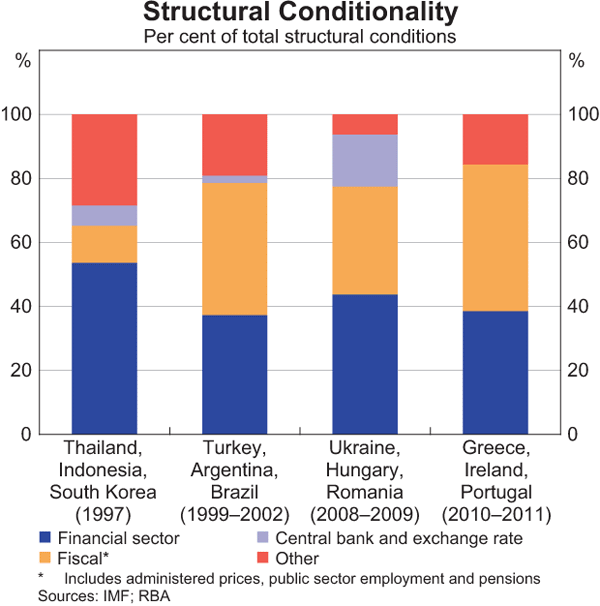
On the other hand, conditions pertaining to the financial sector have consistently comprised a large proportion of structural conditionality, accounting for 43 per cent of the total conditions imposed across the entire sample, and more than half of the conditions in the three Asian crisis arrangements. Resolving financial sector vulnerabilities was an important priority of the Asian programs, and a large proportion of the structural reform conditions involved dealing with non-viable financial institutions, recapitalising viable institutions, and improving prudential regulations and supervision.
Fiscal conditions have also been prominent in most programs in our sample, with the exception of the Asian crisis programs. Notably, fiscal conditions comprise just under half of the total structural conditions in the arrangements for Greece, Ireland and Portugal. The fiscal conditions in these arrangements have been quite varied, although tax recovery, expenditure monitoring and control, and improving fiscal transparency are common themes.
Footnotes
The authors are from International Department. [*]
For previous discussions of IMF financing activities, see Doherty (2009) and Brassil (2010). [1]
The PLL is also available as a six month arrangement, in contrast to the PCL, which was only available for periods of one to two years. [2]
This does not include a FCL arrangement for Poland which was cancelled in 2011, and replaced by a new FCL. [3]
The data in Graph 2 have been adjusted to account for the effect of inflation over time. When lending data are scaled as a proportion of global trade or GDP (see, for example, Brassil (2010)), the recent spike in new lending commitments is less prominent. [4]
This article follows the IMF convention and includes Georgia and Mongolia in the CIS group due to geography and similarities in economic structure. [5]
The €85 billion package for Ireland included a contribution from the Irish authorities. [6]
See, for example, IEO (2007), Ito (2007) and Takagi (2010). [7]
The limits for access in any given year were also doubled from 100 to 200 per cent of quota. These access limits are net of scheduled repayments. See also Doherty (2009). [8]
For more details, see IMF (2009). [9]
PLL (and PCL) facilities involve light conditionality, in keeping with their less stringent qualification criteria. [10]
For more details, see IMF (2009, 2011). [11]
The sample here includes the three largest arrangements (including subsequent augmentations) that were approved by the IMF during each of: the Asian crisis period in 1997; the post-Asian crisis period from 1999 to 2002; the period immediately after the collapse of Lehman Brothers in 2008–2009; and the most recent period of 2010–2011. The data are available at <http://www.imf.org/external/np/pdr/mona/index.aspx>. Previously published analyses such as IMF (2009, 2011) draw on a larger sample of arrangements but do not disaggregate conditions in pre-2002 arrangements by category. [12]
As the IMF categorisation of conditions for pre-2002 arrangements differs from its categorisation of conditions in more recent arrangements, some recategorisation was required to make the coverage of each of the four categories of conditions used in this analysis as consistent as possible across the four groups of arrangements. [13]
References
Brassil A (2010), ‘The Impact of the Financial Crisis on IMF Finances’, RBA Bulletin, September, pp 71–75.
Doherty E (2009), ‘IMF Initiatives to Bolster Funding and Liquidity’, RBA Bulletin, November, pp 7–10.
IEO (Independent Evaluation Office of the IMF) (2007), ‘Structural Conditionality in IMF-Supported Programs’, Evaluation Report.
IMF (International Monetary Fund) (2009), ‘Review of Recent Crisis Programs’, Staff Paper SM/09/246.
IMF (2011), ‘Update of Review on Crisis Programs’, Staff presentation. Available at <http://www.imf.org/external/np/spr/2011/crisprorev/index.htm>.
Ito T (2007), ‘Asian Currency Crisis and the International Monetary Fund, 10 Years Later: Overview’, Asian Economic Policy Review, 2(1), pp 16–49.
Takagi S (2010), ‘Applying the Lessons of Asia: The IMF's Crisis Management Strategy in 2008’, Asian Development Bank Institute Working Paper No 206.